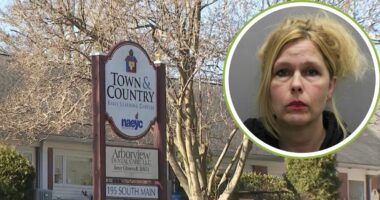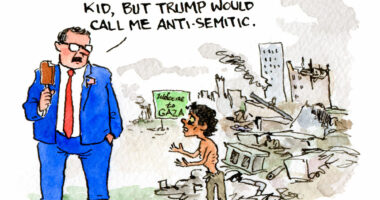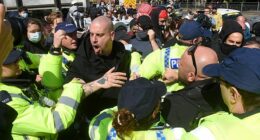Melbourne likes to hide behind the idea it’s smarter than the rest of Australia.
Cultured and classy with a love of fine dining, better coffee and a thriving music scene, it has long scoffed at other Australian cities it felt was beneath it.
For seven years, from 2011 to 2017, it was even named the world’s ‘most liveable city’, based on healthcare, culture and environment, education and infrastructure.
Then came Covid-19 and with it the world’s focus on what had become a city stuck in the planet’s longest lockdown.
The pandemic ended what many Melburnians loved about their own city and now the gaping chasm in its façade lays raw and open for all to see.
Today, the city is grappling with youth violence, firebombings and the shocking murders of women.
The populace has lost faith and trust in both its police force and politicians.
Down on the streets there remains what many older residents will argue has been a problem nearly as old as them: drugs.

Drug addicts shoot up in public in St Kilda. They do it without care for who is walking past them

A woman drags on a smoke while sprawled along the footpath as ordinary Melburnians go about their business
Heroin reached epidemic proportions on the streets of Melbourne during the 1990s.
Teens venturing along Victoria Street in Richmond back then, or through the alleys of Collingwood to Victoria Park, will remember the shock of seeing needles discarded like cigarette butts.
Police officers who worked the beat in those days now reflect fondly on that period.
Heroin addicts, while troublesome, were not usually violent in the ways a new breed of addict would become.
Victoria Street, even during its prime period of housing heroin addicts, still enjoyed a thriving Vietnamese community.
Restaurants remained packed and people continued to flock to the area to soak up the gritty atmosphere.
It is a shell of itself today.
Just a few kilometres down the road, in St Kilda, Grey Street residents awaken to scenes straight out of a horror movie.
It is a precinct notorious for illegal sex workers, pimps, addicts and worse.

A drug addled man swats away imaginary bugs as he makes his way along the street

Drug dealers do their dirty trade on the streets of Melbourne

Victoria Street in Richmond has long been a haven for wandering drug addicts. It once had a thriving Vietnamese community that has largely moved on

Drug-affected people sit on the footpath outside a busy supermarket

A mentally troubled, drug-affected (or both) man makes his way down the road
Like Victoria Street, Fitzroy Street around the corner has largely gone to the weeds.
One St Kilda resident tells me the community has had a gutful of ‘junkies’ littering their streets.
The mother-of-one, who wished to remain anonymous for obvious reasons, moved to Little Grey Street a year ago and says in that time she has had almost daily interaction with addicts shooting up outside her $1,200-a-week apartment.
The terrified young mum, who moved into the area oblivious to its already seedy reputation, admits she often leaves her house to find uncapped needles laying waste on the footpath.
Other days addicts can be found trawling through rubbish bins ‘looking for anything they could sell for their next fix’.
‘We are packing up and moving in the next month. We’ve had enough. With a young baby it just isn’t safe anymore,’ she says.
She isn’t being paranoid. A home just a stone’s throw away from hers has been on the market since she arrived there, unable to find a buyer.
While heroin has long been a scourge in Australia, the reality is that we are now also one of the most lucrative markets in the world for methamphetamines.
In the year to August 2023, Australians smoked, snorted and shot up about 10 and a half tonnes of the deadly drug known as ice – a 17 per cent increase on the year before.
Unlike smack, meth keeps its users awake and can turn them into violent monsters.

The drug business takes place in broad daylight in and around the city of Melbourne

Many homeless people have hit rock bottom by the time they make it to the injecting facility
Statistics released only recently showed meth was the narcotic of choice for drug dealers in Victoria.
There were 28,770 drug offences recorded in the year to June 2024, according to data published by the Victorian Crime Statistics Agency. Meth made up 34 per cent of all dealing and trafficking charges.
The statistics also showed meth users were not confined to the inner city streets of Melbourne.
Almost 6,000 meth possession offences were recorded statewide in Victoria – 24 per cent of all drug possession offences – with just 392 of them occurring in Melbourne.
The regional city of Geelong, and Dandenong and Knox in Melbourne’s south-east, were also meth possession hotspots.
It wasn’t hard for a Daily Mail Australia photographer to find evidence of both drugs’ hideous effects on those that were addicted to them.
Toothless, pock-marked, filthy and living on the streets in a meth-fuelled haze that kept them detached from otherwise ordinary society.
All around them, people attempted to go about their business in the hope of ignoring a problem that seems will never really go away.
Melbourne Homeless Collective founder and managing director Donna Stolzenberg says her workers are busier than ever.
‘So many people have been tipped into homelessness due to the housing affordability crisis… we’re doing a full Pajero-load daily of essential goods being delivered out there and we can’t keep up. They need everything,’ she says.
‘If you have a car to sleep in, you’re not considered homeless now. People don’t realise there are homeless professionals like doctors out there. The landscape of homelessness has changed entirely.’

Daily Mail Australia has blurred the identifying features of those published to hide their identities. Their faces often make for harsh viewing due to years of drug abuse

North Richmond residents are fed up with drug addicts in their area

A homeless man hides the blazing sun from his face as he tries to catch some sleep on the mean streets of Melbourne
In North Richmond, where the Victorian Government has controversially placed a permanent injecting facility, residents endure daily insight into a part of life they have no interest in participating in.
In August, dramatic footage emerged of what appeared to be a schoolgirl being hit in the face by a drug-affected woman outside the facility.
It is the kind of disturbing incident that now goes unreported to police in the area.
‘Guaranteed under reported too as many have given up on reporting crimes as police don’t have time to investigate,’ one resident claims.
A spate of shocking incidents near the injecting room have been reported since it opened in June 2018.
A public Facebook group titled ‘Move the injecting room’ has more than 1,200 members and contains a smorgasbord of horror stories.
New posts appear practically every day and depict what can only be described as a wasteland of depravity set among suburban family households.
Yarra City Council claims to have spent $1.7million on its ‘syringe management services’ in and around the precinct sine July 2020 to June this year.
But homeowners around the facility claim the value of their properties have nose-dived by tens of thousands of dollars due to the mess.
The situation continues to be discussed regularly on Melbourne talkback radio years after the facility opened.
Only recently, 3AW’s Tony Moclair unleashed on the toxic environment hard-working residents were made to put up with, comparing it with Los Angeles’ notorious Skid Row.
‘The absolute disgraceful state of the nearby streets, littered with rubbish, excrement and used syringes is inexcusable,’ he told listeners.
‘The fact that residents have to walk through this filth and children have to walk past disease-ridden drug paraphernalia, discarded mattresses and garbage-filled trolleys in order to get to school is totally and utterly unacceptable.’
Sharon Neven, who is a regular contributor to the Facebook page, told Moclair that while residents understood the facility was opened with the intention of ‘saving lives’, the surrounding area needed to be maintained.
‘There is no accountability, there are no consequences, no one owns the area… you report something, they come around, they pick up a bag of rubbish and drive past all the rest of the needles and rubbish and things that are lying around. It’s just a joke,’ she said.

A homeless man catches some rest in a residential park in Melbourne’s inner suburbs

A distraught woman talks to herself on a busy street

Groups of seemingly homeless and drug-affected people gather near Richmond’s drug-injecting facility
On September 3, parents picking up their children from school were confronted by the body of a man who had overdosed just outside its gates.
‘It’s not just [garbage]; it’s dead bodies that they need to walk past,’ Ms Neven said.
‘When you want to walk to the community health clinic it’s full of drug users injecting right in front of your face, abusing you. And they’re not being looked after either, which I think is a real tragedy that users you’ve known for 10 years are still using.
‘They’re not getting help, they’re not doing what they were supposed to do.’
Ms Stolzenberg says the injecting facility deals with people at their ‘rock bottom’.
‘The injecting place is usually a good place for niceness about homelessness but by default they deal with those who are always at rock bottom,’ she explains.
‘If you’re homeless and not using, you don’t need them. If you’re using and not homeless you also don’t need them.’
A spokesperson for Yarra City Council insists its cleaning teams are on the ground in the Lennox Street area daily Monday to Friday to monitor and collect litter from ‘council-managed areas’.
‘While we’re out there every weekday, keeping the area clean is a massive task and that’s why we encourage our community to contact council to report any hard rubbish that’s on the street,’ the spokesperson says.
It is understood the council is responsible for cleaning and maintenance of the street and footpaths on Lennox, Egan and Elizabeth streets.
The Department of Families, Fairness and Housing is responsible for the cleaning and maintenance of properties it owns, including the North Richmond Housing Estates, North Richmond Community Health and the public open space on the corner of Lennox and Highett Street.

A truck driver expresses concern about what appeared to be a drug-affected man crossing the street

A man hunches over in a Richmond park
St Kilda residents know all too well the scourge of drug-related crime on their community.
Months ago, a young mum said police had been called to her street after a local business owner discovered drag addicts had commandeered a vacant garage.
Inside, they had been storing thousand of dollars’ worth of items stolen from the wealthy Bayside area.
When police turned up, they discovered several addicts living in the garage unbeknownst to the owner.
‘Their behaviour is so erratic it’s not safe anymore to walk the streets of St Kilda,’ she says.
‘Most of them are like zombies. St Kilda has gone from being this vibrant, idyllic spot to a junkie wasteland. It’s the shame of Melbourne.’
Another St Kilda resident claims the addicts there have no regard for people or property.
‘All they care about is the next high. It’s a disgrace,’ the woman says. ‘It’s certainly not an environment any parent would want their child growing up in or around.’
Local shopkeepers are known to be equally as frustrated as residents.
Many have to deal with addicts camped outside their stores and threatening and intimidating customers, with one business owner saying it’s ‘a disgrace’.








